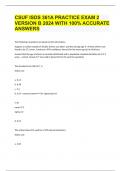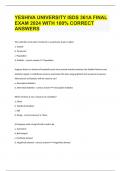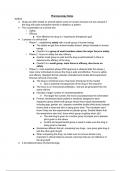Yeshiva University
Latest uploads at Yeshiva University. Looking for notes at Yeshiva University? We have lots of notes, study guides and study notes available for your school.
-
5
- 0
-
1
All courses for Yeshiva University
Latest notes & summaries Yeshiva University
CSUF ISDS 361A PRACTICE EXAM 2 VERSION B 2024 WITH 100% ACCURATE ANSWERS The following 5 questions are based on this information. Suppose a random sample of 18 uber drivers was taken, and the average age X¯ of these drivers was found to be 27.5 years. Construct a 99% confidence interval for the mean age (µ) of all drivers. Assume that the age of drivers is normally distributed with a population standard deviation (σ) of 2.3 years. - correct answer You need to know this for the next fiv...
YESHIVA UNIVERSITY ISDS 361A FINAL EXAM 2024 WITH 100% CORRECT ANSWERS The collection of all units of interest in a particular study is called a. Sample b. Parameter c. Population d. Statistic - correct answer Population Suppose there is a dataset of baseball scores from several matches between the Seattle Mariners and Anaheim Angels. A statistician wants to summarize the data using graphical and numerical measures. What branch of Statistics will she need to use? a. Descriptive St...
Test bank for Medical-Surgical Nursing, 10th Edition Concepts for Interprofessional Collaborative Care by Donna D. Ignatavicius
Notes on Pharmacology course. Discusses Types of administrations of drugs, forms of elimination, pharmacokinetics, pharmacodynamics, half life, drug-drug interactions, dosing frequency, treatment of asthma, Alzheimer's, parkinsons, diabetes, etc.
Abnormal Psychology Chapter 1: Introduction and Methods of Research 4 Definitions (p. 4-6) 4 How Do We Define Abnormal Behavior? (p. 6-10) 4 Historical Perspectives on Abnormal Behavior (p. 10-19) 4 Research Methods in Abnormal Psychology (p. 19-32) 6 Chapter 2: Contemporary Perspectives on Abnormal Behavior 7 The Biological Perspective (p. 38-45) 7 The Psychological Perspective (p. 45-60) 10 The Sociocultural Perspective (p. 60-63) 13 The Biopsychosocial Perspective (p. 63-66) 14 Cha...





